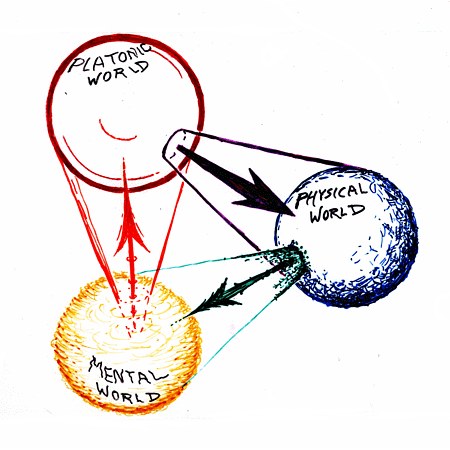The theory of the three worlds
There are practical questions which concern our specific lives, and there are theoretical questions which seemingly don’t. However, there are also theoretical considerations which definitely concern our practical everyday lives. One of these is the three worlds theory, which deals with questions as to which worlds we specifically live in.
On what foundation is our everyday existence based? The theory of the three worlds points to the fact that we simultaneously live in three completely different worlds. Practically, this does not constitute a problem for us; theoretically, however, the question arises as to how three worlds which are so different from each other are able to meet in reality at all.
Roger Penrose has named the three worlds as follows:
A) the Platonic world,
B) the physical world,
C) the mental world.
This is Roger Penrose’s original graph:

Platonic world: The world of ideas. Mathematics, for example, is completely located in the Platonic world.
Physical world: The real, physical world with things that are in a specific place at a specific time.
Mental world: My subjective perceptions without which I would not be able to recognise the other worlds, but also my thoughts and ideas as I experience them.
The circular relationship between the three worlds
The arrows between the spheres indicate the circular relationship that these worlds engage in together:
Platonic → physical: Behind physics, there is mathematics. Physics is inconceivable without higher mathematics. Evidently, the physical world complies with mathematical laws with a staggeringly accurate precision. Is the real world therefore determined by mathematics?
Physical → mental: My brain is part of the physical world. According to common understanding, the neurons of the brain tissue determine my brain performance with their electric switches.
Mental → Platonic: Great thinkers are capable of formulating the laws of mathematics in their thoughts (mental world); these laws “come into being” in their heads.
This, then, is the circular process: The Platonic world (mathematics) determines the physical one, which is the basis of human thought. In human thought, in turn, mathematics (and other ideas) are located. These mathematical laws … and here we come full circle.
The scope of the three worlds
What is also interesting are the opening funnels in Penrose’s sketch, which together with the arrows point from one world to the next. Penrose uses them to indicate the fact that the world that follows in the circular process merely requires part of the world from which it emerges during the generation process.
Platonic → physical: Only a small part of mathematical findings can be used in physics. Seen in this light, the physical laws only need (are?) an excerpt from mathematics.
Physical → mental: My brain is a very small part of the physical world.
Mental → Platonic: My brain deals with many things; mathematics and abstract ideas are only a part of it.
The Platonic world is then the origin of the physical world again. However, the proportions do not appear to work out properly. This resembles the famous impossible staircase:
The impossible staircase
As an aside:
The impossible staircase was discovered by Roger Penrose’s father, Lionel Penrose, and is also called the Penrose steps – or the Escher-Penrose steps after the Dutch graphic artist who, inter alia, inspired Douglas Hofstadter to write his book Gödel, Escher, Bach. The endlessness with which the steps ascend can seemingly be graphically represented without any problems, but from a logical point of view it is eminently intricate (self-referential taboo).
For Penrose, there is a mystery in the three worlds. He writes that undoubtedly there are not three separate worlds in reality but only one, and at present we are not even able to divine the true nature of this world. This is therefore about three worlds in one – and thus about their differences and the form of their interlinkage.
Not an abstract theory
The three worlds are not an abstract theory but can be recognised in our own world of private experiences. They play an important part in music, for instance. The example of music also enables us to see how the three worlds interact. More about this on this website.
Translation: Tony Häfliger and Vivien Blandford
Herr Straub, Beautiful description and depiction of the three worlds. BTW, I’m an Escher fan and a several times reader of Hofstadter’s Godel, Escher, and Bach.
Thanks a lot